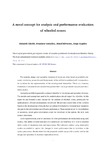Mostrar o rexistro simple do ítem
A novel concept for analysis and performance evaluation of wheeled rovers
| dc.contributor.author | Ghotbi, Bahareh | |
| dc.contributor.author | González Varela, Francisco Javier | |
| dc.contributor.author | Kövecses, József | |
| dc.contributor.author | Angeles, Jorge | |
| dc.date.accessioned | 2023-05-11T06:42:33Z | |
| dc.date.available | 2023-05-11T06:42:33Z | |
| dc.date.issued | 2015-01 | |
| dc.identifier.citation | B. Ghotbi, F. González, J. Kövecses, J. Angeles, A novel concept for analysis and performance evaluation of wheeled rovers, Mechanism and Machine Theory, Volume 83, 2015, Pages 137-151, ISSN 0094-114X, https://doi.org/10.1016/j.mechmachtheory.2014.08.017. | es_ES |
| dc.identifier.issn | 0094-114X | |
| dc.identifier.uri | http://hdl.handle.net/2183/33057 | |
| dc.description.abstract | [Abstract] - The analysis, design, and operation planning of rovers are often based on predictive dynamic simulation, where the multibody model of the vehicle is combined with terramechanics relations for the representation of the wheel–ground interaction. There are, however, limitations in terramechanics models that prevent their use in parametric analysis and simulation studies. Increasing mobility is generally a primary objective for the design and operation of rovers. The models and assumptions used in the analysis phase should target this objective. In this paper we put forward a new concept for the analysis of wheeled rovers, particularly for applications in off-road environments on soft soil. We propose a novel view of the problem based on the development of models that are primarily intended to represent how parameter changes in the robot design can influence performance. These models allow for the definition of indicators, which gives information about the behavior of the system. We term such models observative. In the reported work, a set of indicators for rover performance is formulated using such models. The ability of these indicators to characterize the behavior of a rover is assessed with a series of simulation tests and experiments. The indicators defined using observative models succeeded to capture the changes in rover performance due to variations in the system parameters. Results show that the proposed models can provide a useful tool for the design and operation of planetary exploration rovers. | es_ES |
| dc.language.iso | eng | es_ES |
| dc.publisher | Elsevier | es_ES |
| dc.relation.uri | https://doi.org/10.1016/j.mechmachtheory.2014.08.017 | es_ES |
| dc.rights.uri | http://creativecommons.org/licenses/by-nc-nd/3.0/es/ | * |
| dc.subject | Wheeled mobile robots | es_ES |
| dc.subject | Planetary exploration rovers | es_ES |
| dc.subject | Terramechanics models | es_ES |
| dc.subject | Terrain interaction | es_ES |
| dc.subject | Observative models | es_ES |
| dc.subject | Robots móviles con ruedas | es_ES |
| dc.subject | Rovers de exploración planetaria | es_ES |
| dc.subject | Modelos de terramecánica | es_ES |
| dc.subject | Interacción con el terreno | es_ES |
| dc.subject | Modelos observativos | es_ES |
| dc.title | A novel concept for analysis and performance evaluation of wheeled rovers | es_ES |
| dc.type | info:eu-repo/semantics/article | es_ES |
| dc.rights.access | info:eu-repo/semantics/openAccess | es_ES |
| UDC.journalTitle | Mechanism and Machine Theory | es_ES |
| UDC.volume | 83 | es_ES |
| UDC.startPage | 137 | es_ES |
| UDC.endPage | 151 | es_ES |
| dc.identifier.doi | 10.1016/j.mechmachtheory.2014.08.017 |
Ficheiros no ítem
Este ítem aparece na(s) seguinte(s) colección(s)
-
LIM - Artigos [51]






